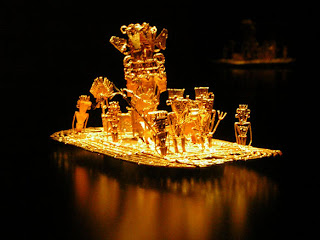El Dorado 黄金岛
E
|
l Dorado, the word comes from Spanish mean for “the golden one”. El Dorado is a fabulous country with immeasurable treasure. El Dorado is the name of a Muisca (ethnicity of Muisca people) tribal chief who covered himself with gold dust and, as an initiation rite, dove into the highland lake (Lake Guatavita). El Dorado has been known by several names over the years such as The Seven Cities Of Cibola, The Seven Cities Of Antillia, Manoa, Quiviera, Paititi, Land of the Golden Man, and Land of the Golden Serpent.
Tribal ceremony
The ceremonial site of Muisca was held at the sacred lake of Guatavita where the Indians worshipped Chie, the goddess of water. In the ritual, the Zipa(the ruler of the southern part called Bacata) or Zaque(the ruler of the northern area in Hunza) with his four priests arrive at the lake on a wooden raft. The Muisca chief covered his body in gold powder, then venturing out into the water on a ceremonial raft, he dove into the waters washing off the gold. After that, trinkets, jewelry, and other precious offerings were thrown into the waters by worshipers to Guatavita goddess. For the natives, the value of gold was not economic but a means to come closer to their gods. This is believed that the legend of El Dorado started.
*the ceremony took place on the agreement of a new ruler. Prior assuming office, he been isolated and stay in a cave, without woman, not allow to eat salt and chili pepper, or to go out during daylight. The first journey he had to make to the lake Guatavita, to make offerings and sacrifices to the demon which they worshipped as their god and lord. The raft has four lighted braziers with the content of incense. As the raft begin to burn the Indian incense called moque, natives also lit braziers on the shore for purpose of the smoke to hide the light of day. At this time, they stripped the heir to his sin and anointed him with mixture of gold powder and soil until he covered this metal completely. After that, they placed him on the raft with heap of gold and emeralds to offer god. When the raft reached in the middle of lake, he will do the ritual. After this they lowered the flag, which had remained up during the whole time of offering, and as the raft moved towards the shore the shouting began. With this ceremony the new ruler was received and was recognized as lord and king.
Interesting things: if Zipa needed to spit, someone would hold out a piece of rich cloth for him to spit on, because it would be sacrilegious (亵渎神灵) for anything so precious as his saliva to touch the ground.
This story came to ears of the Spaniards. The Conquistadores had quickly taken over the Muisca city and their treasures. The Spaniards realized that there were no golden cities, nor even rich mines. But at the same time, the Spanish began to hear stories of El Dorado from captured Indians, the rite which held in the middle of lagoon of Guatavita. The Spaniards attempted to drain the lake several times. The high cost of expeditions (远征)made them give up, but not after obtaining the best part of booty. The gold they took was a lot and very heavy; very little has been recovered.
The Muisca Raft
The myth of Guatavita lake
There is one of the Pre-Columbian myths concerning Lake Guatavita of the tribal Cacique (chief) and the serpent god believed to live in the waters.
The chief discovered that one of his wives in love with another man. He had murder her lover and then forced her to eat the dead man’s sex organ. He also paid musician to compose and sing song about her disloyalty around the town. She brought her baby daughter escape from home and throwing themselves to the lake. The chief was very regretted of his action and ask for help from the local shaman to find a way of bringing her and the baby back. The shaman made a sacrifice to the serpent god of the lake and throw heated stones into the waters—after which he dove in and swam to the deep. The shaman found that the chief’s wife and his daughter living on the bed of the lake with the serpent god, he then reported this to the chief. The chief ordered the shaman to bring his wife and daughter back to him. After long hour, the shaman returned with the corpse of the child. When battling the serpent god, the serpent god devoured the child’s eye and the baby had died. Meanwhile, the wife remained at the bottom of the lake with serpent god.
Is the El Dorado Exists?

However, I have found a website claim that the real El Dorado finally rediscovered.
Why has the search for El Dorado been so important to so many people for so many years?
This is because El Dorado was the single largest source of gold for both the Inca and Spanish empires. Literally, many tons of gold were produced from El Dorado before its destruction. Many tons of gold still remain to be produced from The Seven Lost Cities of El Dorado today.






No comments:
Post a Comment